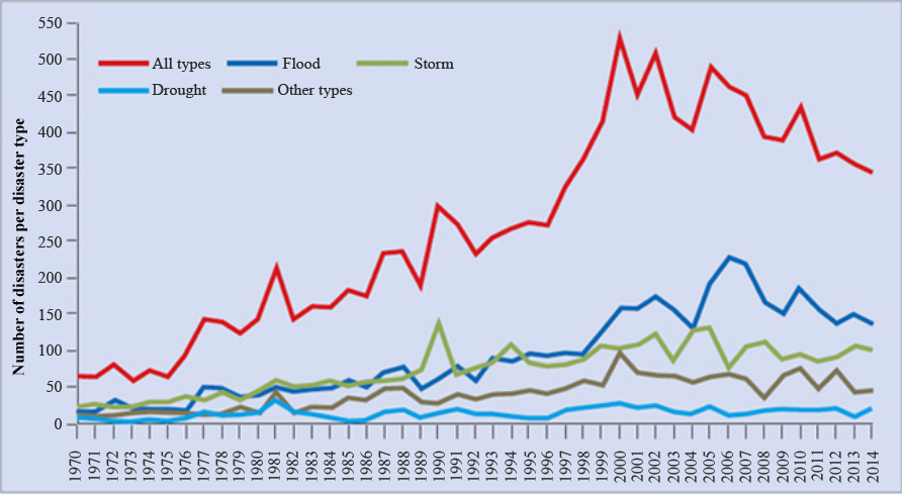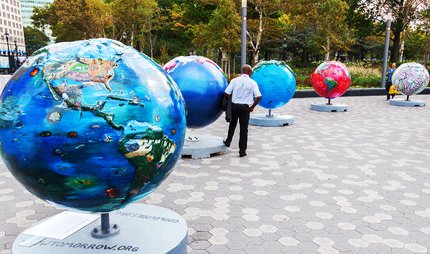Climate Change and Water Scarcity in India
India is running out of water. Sounds bothersome, right? Well water is life, but it is a scarce resource. Climate change is only adding to water scarcity in India. Essential for the sustenance of life, water crisis is real. With dwindling rivers and nearly exhausted groundwater, India faces extreme water paucity in the coming days.
India is running out of water. Sounds bothersome, right? Well water is life, but it is a scarce resource. Climate change is only adding to water scarcity in India. Essential for the sustenance of life, water crisis is real. With dwindling rivers and nearly exhausted groundwater, India faces extreme water paucity in the coming days.
Changes in temperature, monsoon pattern, and humidity are only compounding the problem, which are likely to have long-term implications. This will adversely affect the quality and quantity of water in the world’s second-most populous nation. This is serious food for thought!
Why Climate Change Is Causing Water Scarcity in India
Imagine a situation where there is no water. Sounds scary! The country’s natural resources are under increasing pressure from population explosion, reckless industrialization, improper management of rivers, increasing urbanization, and inefficient water use.
Water crisis is a situation when there is more demand for drinking water than supply. Climate change is causing a shift in the water cycle. The hydrologic cycles comprising evaporation, precipitation, runoff, and evaporation are critical for agriculture and forests, generating the runoff in rivers and streams.
With temperatures soaring, the rate of evapotranspiration is rising from the land, vegetation, and oceans. More evaporation means speedy drying of water on the land. Unfortunately, it contributes to a higher amount of moisture retention in the warmer atmosphere, eventually resulting in more precipitation. Sadly, warmer climate results in more rainfall and less snow. Higher amount of rainfall leads to an increased risk of flooding.
Since snow is a form of natural water storage, it is lost in the process, further contributing to climate change. When the extra warm and moist air cools down, it results in rainfall or snow. Thus, with a warmer world, we can expect to receive a higher intensity and frequency of rain and snowstorms.
Unfortunately, some areas may bear the brunt of climate change in India and experience less precipitation. With the rain seasons becoming shorter, there is a higher likelihood of longer periods of severe drought. As a result, the need for irrigation will increase, further increasing water demands. This will trigger a vicious cycle of water scarcity.
The climate change-induced change in temperature and circulation patterns is expected to alter the amount and intensity of precipitation. Some areas are expected to get drier further and others will keep getting wetter. Sadly, such precipitation projections are already a reality.
Statistics reveal that per capita availability of water has dropped by 70 percent since 1950. According to the Indian Institute of Tropical Meteorology, the hydrological cycle is expected to become more intense while annual average rainfall will increase.

Extreme rainfall and intensity is expected to increase in three river basins by the end of the 21st century, with the Godavari basin likely to register higher precipitation.
There will be an increase in the intensity of daily rainfall.
There could be extreme changes in the number of rainy days, with the western Ganga basin predicted to experience decrease in rainfall. On the other hand, the number of rainy days are expected to increase in the Godavari and Krishna basins.
Along the Sundarbans coast, the first signs of sea level rise are already visible. This threatens to submerge the coastland and destroy the ecosystem.
Coastal cities and low-lying areas are showing signs of increased erosion due to the gradual destruction of coral reefs and wetlands.
Rising marine temperature has resulted in the bleaching of coral reefs along the Indian coast.
Impact on Rural and Urban Life

The current water crisis situation is already forewarning you about the effects of global warming and climate change on India’s water resources. With water availability becoming less predictable, it poses a serious threat to food security. The shifting rainfall and snowfall patterns threaten to throw life in disarray and do extreme damage to agriculture.
Warming lakes and streams are a threat to the marine life and aquatic organisms. Not to mention, it is beginning to devastate fisheries. In fact, as runoff dumps sediments and contaminated water into streams, it endangers wildlife. Some regions are experiencing severe droughts already while others are inundated with flash flood. Drought is worsening the water scarcity in India and adversely affecting health and productivity. Water-deprived rural populations are forced to look for greener pastures where they can find a constant supply of this lifeline.
While glaciers are retreating in the Himalayas and the Indian monsoon is becoming more variable, it is having a profound impact on sea levels. Rising sea levels, on the other hand, pose a serious threat to coastal wetlands and communities that sustain on marine life. Fertilizer runoff into water bodies can cause algae blooms, which threaten aquatic life. Sadly, the problem is further worsened by warming water that is deprived of oxygen, threatening the survival of fish.
More precipitation means an increased rate of snow melt and less storage of water as snowpack. It also means drier conditions in urban areas that rely on snowmelt for the replenishment of drinking water stores. Urban communities are already starting to face water shortages due to the decline in snowpack.
Chennai is faced with a severe water crisis. By 2030, Delhi and Chennai are likely to lead the pack of cities that will run out of water.
If you believe statistics, Niti Aayog released a Composite Water Management Index report in 2018 on 21 major cities of India, which are faced with water crunch by 2020. Delhi, Bengaluru, Chennai, and Hyderabad face a severe water crisis and could reach zero groundwater levels by then. Further, the report alarms that 40% of the population will have no access to drinking water by 2030. If this isn’t enough, at least 600 million people are starved of water. Sadly, two lakh people are reported to lose their lives due to inadequate access to water.
There are more alarming statistics to prove that water scarcity in India is real. About 72% of districts in Maharashtra are hit by drought and dependent on water tankers to villages and settlements.
The per capita availability of fresh water is estimated at about 2,000 m3 per year, which is expected to drop to 1000 m3 by 2025 due to increase in the population coupled with no further augmentation of water resources.
Impact on economy
The impact of constantly rising temperatures and climate change in India may be felt more severely on the economy. Since the Indian economy is primarily dependent on agriculture, water paucity and population explosion are compounding the demands for food, fresh water, and energy.
Sadly, conflicts between agricultural and domestic users and industrialists will increase. Agriculture will be faced with a tough fight against investors and industrialists. While farmers are facing water crisis already, they will have to compete against factories, infrastructural projects, and tourist resorts for water.
Water scarcity threatens severe economic implications. The impact on businesses will be immense due to the exponential growth in the price of water. Businesses will regard water access as competitive advantage to keep a check on operating costs and staying competitive.
The lack of water is likely to have a domino effect, resulting in a decline of local commerce and tax revenue. This will further exacerbate the situation, and incomes will go down, and unemployment rates will increase.
According to a World Bank report, climate change driven water scarcity could cost some regions of the country about 6% of the GDP. Not only this, such water crisis could spur migration and spark a water war.
The World Bank report warns that unless India manages its water crisis, the country stands to lose 6% of the GDP by 2050. By affecting agriculture, income, and health, India’s water deficit can erode its economic growth.
What Can Be Done To Rectify The Situation
India’s water situation is a stark reminder of how climate change is affecting one of the most essential natural resources.
Therefore, the current water scarcity scene in India deserves special attention and management of dwindling resources. The establishment of efficient water equipment and proactive steps can help reduce the wastage of water resources.
Some successful initiatives in managing water crisis in India: ‘Mukhya Mantri Jal Swavlamban Abhiyan’ scheme has been launched with a mission to ensure water conservation and harvesting in rural Rajasthan. ‘Jalyukt-Shivar’ scheme in Maharashtra aims to alleviate water scarcity in 5000 villages every year. The interlinking of rivers project has been in the pipeline for over 20 years but there is still no hope from it as states are unwilling to submit their authority over the river basins. Marathwada region of Maharashtra has been starved of water for a long time. To deal with this water crisis, the government has set up water ATMs, supplying water at 25 paise per liter.
It would also help to set up minimum support price on crops that consume a lot of water. Besides, local participation in water conservation can play a big role in altering the face of the region. Hiware Bazar, a rural area in the drought-prone district of Ahmednagar, Maharashtra, was water stressed after its environmental degradation.
Luckily, with local efforts and community support, the village has turned itself into one of the most prosperous villages in India, regenerating its natural resources and harvesting rain water. The village has set up an example for the rest of the country to show how to harvest rainwater, managing 300-400 mm of its annual rainfall.
The need of the hour is to conserve our natural resources and keep a check on the rising temperatures due to the constant harm being done to the environment. Sadly, this triggers a vicious cycle of global warming, climate change, and water paucity. Water management holds the key to rescuing billions of people from the looming water crisis.
Sources
https://www.adriindia.org/adri/india_water_facts https://www.pnas.org/content/108/15/6312


